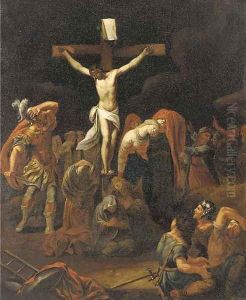Jan Tegnagel Paintings
Jan Tegnagel was a Dutch painter, draughtsman, and poet, born in 1582 in Amsterdam, Netherlands. His work is often associated with the Dutch Golden Age, a period in the 17th century during which Dutch art, science, trade, and military were among the most acclaimed in the world. Tegnagel's contributions, particularly in painting, reflect the rich cultural and artistic environment of his time.
Tegnagel's artistic journey began in his native city of Amsterdam, where he likely received his initial training. The specific details of his education in art remain somewhat obscure, as do many aspects of the lives of artists from this period. However, it is known that he traveled to Italy, a common practice among artists of his time seeking to study Renaissance masterpieces firsthand and to absorb the influence of Italian masters. This experience deeply influenced his style, incorporating the Italianate influences prevalent among Dutch artists of the early 17th century.
His works are characterized by a keen attention to detail, a mastery of light and shadow, and a preference for biblical and mythological subjects, which were popular among the patrons of his time. Tegnagel was also known for his portraits, which capture the socioeconomic status and personality of his subjects with precision and insight. Despite his talent, Jan Tegnagel did not achieve the same level of fame as some of his contemporaries, such as Rembrandt or Vermeer, and as a result, his works are less known to the general public today.
Tegnagel's involvement in poetry and his integration into the intellectual circles of Amsterdam indicate that he was a man of education and wit. This multidisciplinary approach to art and literature was not uncommon among artists of the Dutch Golden Age, who often engaged in multiple forms of artistic and scholarly activities. His poetry, much like his paintings, reflected the themes and concerns of his era, providing a nuanced view of 17th-century Dutch culture.
Jan Tegnagel died in 1635 in Amsterdam. Although he may not be as widely recognized as some of his peers, his work remains an important part of the artistic heritage of the Dutch Golden Age. His paintings continue to be studied and appreciated for their beauty, technical skill, and historical value, offering insights into the era's artistic trends and cultural contexts.
